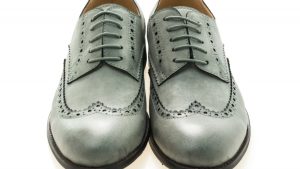Table of Contents
ToggleFinding the Right Fit for Your Plain-Toe Oxfords in Variable Weather

1. Aim for a Balanced Fit
Striking the right balance is key. Start by loosening the laces, slip your foot in comfortably, and ensure the tongue is centered. Then, begin lacing, maintaining an even tension. This allows for adaptability as the weather shifts.
2. Consider Temperature Changes
Weather can be as unpredictable as a surprise party. As temperatures fluctuate, your feet might swell or shrink slightly. So, a moderate snugness is your best bet. Your shoes should feel secure but not constricting.
3. Account for Comfort
Walking around in shoes that feel like a corset is nobody’s idea of comfort. If your feet start feeling cramped or your toes seem like they’re in a wrestling match, it’s time to readjust those shoestrings.
4. The ‘One Finger’ Rule
A nifty trick is the ‘one finger’ rule. After lacing up, you should be able to slide one finger comfortably between your heel and the shoe. It’s a reliable gauge for a snug yet not too restrictive fit.
5. Test and Tweak
Your Plain-Toe Oxfords should make you feel like you’re walking on air. Take a stroll, feel how they respond to your movements. If they feel too loose or too tight, don’t hesitate to tweak the laces.
So,…
The ideal tightness for your Plain-Toe Oxfords in variable weather lies in finding that middle ground a fit that accommodates the changes in your feet due to temperature while providing ample support and comfort.
Remember, your feet are the real VIPs here. Prioritize their comfort, and you’ll stride through any weather with ease.
Maintaining Your Oxfords’ Fit in Changing Weather
Once you’ve nailed the perfect shoestring tightness for your Plain-Toe Oxfords in variable weather, it’s essential to maintain that optimal fit. Here are a few tips to ensure your shoes remain comfortable through the changing seasons:
1. Regular Checks
Just like your car needs a tune-up, your shoes need occasional adjustments. Periodically check the tightness of your shoelaces, especially during significant weather shifts, to accommodate any changes in your feet.
2. Adapt as Needed
Temperature swings can cause your feet to expand or contract. Be prepared to adapt. Loosen or tighten the laces accordingly to keep your shoes comfortably snug without compromising blood circulation.
3. Alternate Shoelace Patterns
Exploring different lacing patterns isn’t just about aesthetics; it can also affect the fit. Experiment with alternate lacing techniques that distribute pressure more evenly across the shoe to find an even more comfortable fit.
4. Quality Matters
Invest in high-quality shoelaces that can withstand weather changes and daily wear. Sturdy, durable laces retain their shape and tension better, ensuring a more consistent fit over time.
5. Shoe Maintenance
Regularly clean and condition your Oxfords to preserve their shape and flexibility. Proper care extends the lifespan of your shoes, ensuring they maintain their original fit for longer.
Conclusion
Ensuring your Plain-Toe Oxfords remain comfortably snug in variable weather isn’t a one-time deal; it’s an ongoing process. Regular checks, adaptability, and proper maintenance are your allies in keeping your shoes fitting just right, no matter what weather surprises come your way.
So lace up, step out, and enjoy your Oxfords, snugly fitted for whatever the elements throw your way!
Comparison tabular
| Aspect | Loose Shoelaces | Optimal Shoelaces | Tight Shoelaces |
|---|---|---|---|
| Fit | Feet may slip | Comfortable, | Uncomfortable, |
| within the shoe | secure fit | restrict movement | |
| Temperature | May accommodate | Best for variable | May constrict |
| Adaptability | temperature | weather conditions | blood circulation |
| Comfort | Potential for | Balanced support, | Constricting, |
| discomfort | flexibility | potential discomfort | |
| Maintenance | Requires less | Moderate checks | Regular checks, |
| adjustment | and adjustments | adjustments |
Here’s a comparison of the different levels of shoelace tightness for your Plain-Toe Oxfords concerning fit, adaptability to temperature changes, comfort, and maintenance. Adjusting the tightness according to your needs and weather conditions can ensure both comfort and functionality.
Wrapping up
Ensuring the right tightness for your Plain-Toe Oxfords in variable weather boils down to finding that perfect equilibrium between comfort and functionality. It’s about giving your feet the support they need without making them feel like they’re on lockdown.
Remember, your shoes should adapt just like you do to changing weather conditions. Keep them snug enough to stay in place but not too tight to cramp your style. Regular checks, a touch of adaptability, and a sprinkle of maintenance are the secret ingredients to keep your Oxfords fitting like a dream.
So, lace them up just right, step out with confidence, and let your Plain-Toe Oxfords be the reliable companions that carry you through sunshine, rain, or that unpredictable mix of both.

Mike the founder of The Shoe String Forum.com, has always had a lifelong love for shoes since he was a kid and with a fervent love for diverse brands like Adidas, Puma, Louis Vuitton, Nike, Birkenstocks, Hey Dudes, Crocs, Vans, Uggs, Converse, and New Balance, he passionately shares extensive footwear research through this platform.
Related Posts
- How tight should you shoestring Wingtip Oxfords for variable weather days?
When it comes to your Wingtip Oxfords and adjusting the tightness of your shoelaces for…
- How tight should you shoestring Saddle Oxfords for variable weather days?
When it comes to Saddle Oxfords shoelaces and variable weather, getting the tightness just right…
- How tight should your Full brogues shoestring be for variable weather use?
When it comes to your full brogues and their shoelaces, finding the right tightness can…
